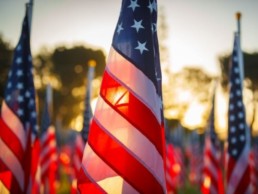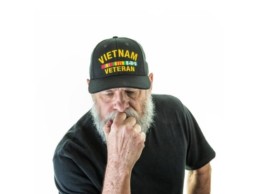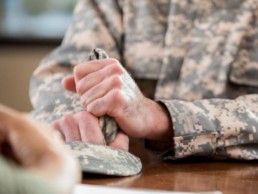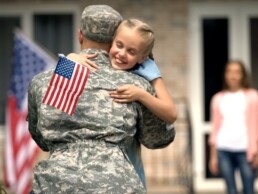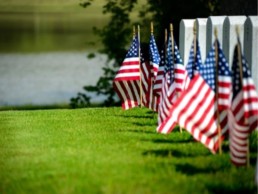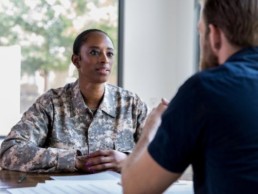4 Ways to Give Back
There are a few days throughout the year when we think about or officially recognize veterans and service men and women. But there are ways to give back to current and former members of our military every day of the year.
Say thank you.
When you see a service man or woman in uniform, or a person wearing something that identifies them as a veteran, take a minute to say hello and thank you. You don’t need to make a big, dramatic gesture; just let them know you appreciate their service. If they feel like talking, take the time to listen to their stories.
Hire a vet.
Do you own a business? Consider hiring a veteran. You can work with the United States Department of Labor’s VETS Program, or similar nonprofit organization that helps vouch for and place qualified veterans in businesses.
Stay informed.
Only a fraction of U.S. citizens currently serve, and few Americans have personal contact with members of our military, causing a disconnect between the military and the civilian worlds. Take some time to get informed about the issues facing our troops and veterans. Follow veteran organizations on social media, and learn about how you can help.
Make a donation.
When you donate to the Purple Heart Foundation, your generous gift helps us to support veterans and their families during their transition from the battlefield to the home front.
Our programs and those to which we award grants support hundreds of thousands of our nation’s heroes. There are many ways you can make a tax-deductible donation.
- Visit our website and make a credit card donation.
- Call us at 888-414-4483 or complete the form to donate your vehicle.
- Schedule a pick-up to donate clothing or household goods.
- Simply text PURPLE to 20222 to make a $10.00 donation right now.
- Consider becoming a Purple Heart Legacy member, and leave a gift from your estate. Call us at 703-256-6139 to discuss your options.
We often get asked how we use your donations. Here is a snapshot. If you want more information, give us a call; we would be happy to share it with you.
We use your generous donations
- To help fund research and assistance that tackle the unseen wounds impacting veterans, things like Post Traumatic Stress (PTS), Traumatic Brain Injury (TBI); suicide, and sexual abuse
- To fund Purple Heart’s Service Officers, who are stationed throughout the country to work with veterans informing them about education opportunities, scholarships, disability compensation, employment training, hospitalization and rehabilitation benefits, pensions, and more
- To employ a full-time attorney dedicated to protecting the interests of wounded servicemen and women and presenting veterans’ claims before a court
Vietnam Veteran to High School History
We all wonder where life will take us, he never wondered, he knew. John Harrison, a sophomore student at North Carolina University, wanted to fly helicopters but the only way he was able to, was by joining the Army. Not many would jump at the idea of joining the military, but he did… just to fly helicopters. Growing up he had a great childhood, a loving family and no regrets. With a clear vision in mind and the love for helicopters in heart, he pressed on with the hopes of making a difference.
It didn’t take long for John to get through Basic Combat Training, pass all qualifications and tests at Ft. Polk, L.A. and confidently begin his service in the United States Army, something he had aspired to do for so long. The transition from civilian to soldier was not an easy one though; it was divided into three parts…
- “The RED phase” is the beginning of your training, to prepare you for what’s to come.
- “The WHITE phase” is where he got most of the physical and psychological strength.
- “The BLUE phase” taught him how to handle weapons.
During the first several months in the military, John really enjoyed his time with fellow soldiers and instructors who only had “Tough love” for him. Since he had prepared well for the Army he was in great shape to withstand just about anything, even though he recalls the weather being too hot. It was so unbearably hot in Vietnam that they would drink 4 to 5 gallons of water, every day.
Many would be surprised how John expresses his take on joining the army, but this experience changed his life, his points of view, and his whole being. In the military you can train and prepare as much as possible, but nothing is like experiencing the challenges and traumas of combat than real life. John went to Officer Candidate School later, where he became Airborne Rifle Platoon Leader and Company Executive Officer.
Not long after, his unit was deployed to Vietnam on a USNS (United States Naval Ship). John joked, that although his accommodations on that ship weren’t great, the food was the best part. Since the ship was old, they had to stop at an island in the Philippines for repairs. While on the island, many of them stayed late in a club and almost ended up getting killed! Then after leaving the island, they came across the end tag of a typhoon and many were having trouble keeping their food down.
Finally, they reached Vietnam. They were told they would be safe because they were being protected by South Korea. One of the scariest and most unexpected moments in Vietnam was the first time he got shot at while walking in the mountains with his platoon. John thought to himself that he had been around shooting ranges so it wouldn’t be such a big deal…but as they kept taking on fire, he felt dumbfounded, he didn’t react, he didn’t really know what to do in that moment. The firefights in Vietnam were nothing like they had trained for.
John lasted 4 years in the Army, and said that it was nothing like he had expected. The military can train you so much, but you will never be completely ready to fight when it comes down to it. He was awarded the Purple Heart medal, because he was wounded during his service in Vietnam. He is thankful every day for not ever being captured as a prisoner of war (POW) and for being able to come home to his family. John retired from the military and went back to school to study Law. He became a well-known attorney and realtor in the Washington-Metropolitan Area. Later he went on to teach law at Bishop Denis J. O’Connell High School where he said he truly enjoyed his time with his students and learned a lot from their different opinions.
Now John enjoys his time traveling, being at home and just enjoying life. He has published two (2) books, in which he narrates his life experiences in Vietnam. From one’s first impression of John though, you wouldn’t think he was a veteran or picture him in the dangerous settings he described to me today. One thing is for sure though, John Harrison is and always will be, “Army Strong”.
Raising Awareness About Post Traumatic Stress
In WWI it was called Shell Shock; in WWII, Battle Fatigue. Korean War veterans were diagnosed with War Neurosis, and Vietnam vets with Post-Vietnam Syndrome. Whatever you call it, Post Traumatic Stress (PTS), as it’s now known, continues to affect hundreds of thousands of veterans.
Today is PTSD Awareness Day, a day to speak up about post-traumatic stress, a condition that’s underreported, misdiagnosed, and, so often, misunderstood.
PTS BY THE NUMBERS:
- 10-13% of combat veterans experience post-traumatic stress in their lifetimes.
- Studies estimate that 1 in 5 military personnel returning from Iraq and Afghanistan has PTS.
- PTS affects to 20% of Operation Enduring Freedom and Operation Iraqi Freedom veterans; 10% of Gulf War veterans, and 30% of Vietnam War veterans.
- 17% of combat troops are women; 71% of female military personnel develop PTS due to sexual assault within the ranks.
- The number of diagnosed cases of PTS in the military jumped 50% in the past year.
SEPARATING MYTH FROM FACT
The psychological scars of post-traumatic stress may be invisible, but its manifestations are not. Left untreated, it can lead to depression, drug and alcohol abuse, or suicide. Despite its prevalence, post-traumatic stress is often ignored, misinterpreted, and sensationalized by the media.
Listening to the stories of veteran experiencing post-traumatic stress can help us separate myth from fact.
MYTH: People begin experiencing PTS immediately after a traumatic event.
FACT: Sometimes symptoms surface months or years after a traumatic event or returning from deployment.
“ I was sober and clean almost 11 years, and I just couldn’t handle it no more, you know, my life. I couldn’t hold a job. I always had problems sleeping…very irritable, the whole bit. Plus, my family was always telling me I should go get some help.”
US Navy ((1971 – 1972))
SN, Ammunition Transporter
Vietnam
MYTH: Service members can never fully recover from PTS.
FACT: When people seek help and maintain a treatment program, post-traumatic stress symptoms can be managed or overcome entirely.
“My ability to overcome the situations that cause me to act negatively and not beneficial to me, are up to me, and I continue to seek treatment. I want to make a choice, not have my depression make the choice.”
Traumatic Brain Injury and the Importance of Connection
Often referred to as the signature injury of the Iraq and Afghanistan wars, the prevalence of traumatic brain injury (TBI) among veterans is higher than it’s ever been. The most common cause of TBI among Operation Enduring Freedom and Operation Iraqi Freedom service members is injuries suffered from Improvised Explosive Devices, or IEDs, used extensively against Coalition Forces.
Many people who sustain a Traumatic Brain Injury recover completely. However, in severe cases, a traumatic brain injury can cause emotional and behavioral changes that can be difficult to understand and accept.
A traumatic brain injury affects the entire family and often results in financial challenges, job loss and isolation. In the United States, 1.7 million people sustain a TBI each year. Whether you have suffered a TBI or are caring for someone who did, understanding you’re not alone is critical, the best thing you can do is reach out.
Join a group
Meeting in person with other people with similar experiences can be cathartic. There are several places to find groups in your area.
Meetup.com has many brain injury and veteran meet ups across the country.
The Brain Injury Association of America has local chapters and various support groups throughout the U.S.
Share your story
When you can share your story and hear the stories of others, you realize there are people out there who understand what you’re going through, who can commiserate, or help put things in perspective. Luckily, the internet makes sharing easier than ever.
Brainline Military is an organization that serves the military community providing information, resources, and support for current and former service members and their families living with traumatic brain injury. Read the personal stories of military members living with TBI, and share your own.
A quick search for “Facebook TBI support group” turns up a handful of pages where you can connect on Facebook and be part of the conversation.
Get Informed
Knowing about traumatic brain injury—the symptoms, treatment options, and benefits you’re eligible for as a veteran or active duty military—will allow you to thrive, not just survive with this condition.
Take a look at our list of TBI resources.
20 is 20 Too Many #BeThere
September 1 marked the start of Suicide Prevention Month. Throughout the month, individuals and organizations have been raising awareness about different suicide prevention programs. Programs such as the Yellow Ribbon Suicide Prevention program, 22Kill, and Operation Never Forgotten all give support to those who are battling suicidal thoughts or actions and give them an outlet to share their frustrations. The Purple Heart Foundation also has a suicide prevention program to help those who may be contemplating suicide.
The topic of suicide can be a difficult topic to bring up, especially if you or someone you love is showing signs of possibly attempting to end their life. The most important thing to remember when having this conversation, according to Dr. Andrew Tomacari, is to show genuine support for the person during this tough period in their lives. Having a heartfelt conversation can help the person open up and start a conversation about how they’re feeling.
In 2014, the Department of Veterans Affairs reported an average of 20 veterans die from suicide each day, and six of the 20 used VA services. There is continued evidence, according to a July 2016 report that middle-aged and older veterans have a high burden of suicide. For families of veterans who have committed suicide, sharing their story can help other veterans who are thinking of ending their life. When Army veteran Daniel Somers committed suicide on June 10, 2013, he asked his wife to share the note he wrote to his family as she saw fit in order to raise awareness.
Holden Corzine, an Army Veteran of the War in Afghanistan ended his life on April 6, 2016. The 29-year-old suffered from PTSD after he came back from Afghanistan and sought out treatment. Even with the help he received, Holden struggled. Holden’s parents share his story in an effort to raise awareness, “My wife and I both thought if it helped one person, it was worth it. All we wanted people to do is get help, hang onto their loved ones, and let them know things would be OK,” Holden’s father Jhan said. “Sometimes that’s not enough.”
One of the reasons for the rate of suicide in the military is the stigma that military personnel need to be strong and not ask for help.“In the past, it was an unwritten rule (in the military) that it was frowned upon if you sought help with (mental illness),” said Chip Tansill, a retired Army colonel and combat veteran and director of the Ohio Department of Veteran Services.
People like the Corzine family and others around the country are trying to raise awareness to help bring down the statistics of veteran suicide. Some of the ways in which people are helping to raise awareness include:
-
Navy veteran and father Marc Herzog of Westfield, NJ marched 13 miles with non-profit organization Irreverent Warriors to raise awareness.
-
The #22PushUpChallenge and #22KILL hashtag has taken the nation by storm with everyone from regular citizens to celebrities to Olympians completing 22 pushups for 22 days straight in honor of the estimated amount of veterans committing suicide each day.
-
During the month on Twitter, the hashtag #BeThere has been used to show that even just being there for a person over the phone or face-to-face can make a difference to someone in crisis and help them get the help they need.
The main theme for this year’s awareness programs and event is being there for someone. Whether it be through a phone call, text message, or sharing a meal with someone, letting them know that they are not alone in their fight may give them the reassurance they need to seek out help.
The fight to end veteran suicide has come to Capitol Hill as well. Sen. Joni Ernst, (R-Iowa), who is a former Lieutenant Colonel in the Iowa Army National Guard, introduced legislation on the topic. Ernst introduced to the Senate the Prioritizing Veterans’ Access to Mental Health Care Act. The proposal included an option for veterans seeking help to look outside of the Veterans Affairs.
She also introduced the Female Veteran Suicide Prevention Act to help reduce the number of female veteran suicides. According to the most recent Veterans Affairs study, female veterans are six times more likely to commit suicide than non-female veterans. The bipartisan legislation, also championed by Democratic senator Barbara Boxer, was signed into law by President Obama in July.
Being available to listen and speak with someone who may be considering taking their life is important. By having heartfelt talks about what they need, the person struggling will hopefully be able to see that they don’t have to fight alone and there are resources available to get them the help they need. One major resource is the Suicide Prevention Hotline. If you or someone you know may be thinking of committing suicide, call 1-800-273-5255 24 hours a day, seven days a week.
The Purple Heart Foundation is committed to assisting veterans in all aspects of their lives, including helping those who are struggling with thoughts of suicide through our suicide prevention program. Show your support for these brave men and women in their fight against suicide by making a one-time or monthly pledge to ensure veterans continue to get the support and benefits they deserve by clicking here.
Servicemen and Service Dogs: A Life Saving Connection
Our servicemen and women have to restart their lives upon returning home from battle. These new challenges can present circumstances far different from those of war. Facing these challenges head on can be daunting for many. Easing back into society can tough, especially for those who suffer from Post-Traumatic Stress (PTS) and Traumatic Brain Injury (TBI). According to the Veterans Administration (VA), between 11-20% of veterans during Operations Iraqi Freedom (OIF) and Enduring Freedom (OEF) have been diagnosed with PTS in a given year.
There are a variety of ways to ensure that transition is as smooth as possible. One of those methods is pairing a Veteran with a service dog. Suffering from PTS can leave an individual feeling isolated from family and friends. Depression and other emotional disorders can surface as well. The method of service dogs is to provide the veteran with a companion trained to help them with basic needs. However, the animal is indirectly re-teaching the veteran how to care for someone, using emotions as communication, and even how to love.
“We think pet dogs, therapy animals and service animals all have a role to play in peoples’ health and veterans’ health. This is all good news. A cold nose is a powerful motivation to get up in the morning,” said Stave Feldman, executive director of the Human Animal Bond Research Institute Foundation. Mr. Feldman discussed studies between the animals and veterans to The Military Times in a recent article.
“He brought me back from the brink,” said Veteran Colonel Roger Lintz, (US Army – Retired) of his Service Dog – Niles. Living with PTS does take time to accept that life may not be the same. This veteran, who honorably served his country, was able to find true companionship with his new four legged friend. Niles was able to help him with remedial tasks around the house and would wake him from nightmares. These nightmares and other issues with PTS nearly became too much to handle. Col. Lintz believes that his companion saved his life when suicidal thoughts started to cloud his mind. Watch the full interview:
The American Psychology Association and The Society Military Psychology have found that this alternative method could help nearly 40% of veterans. Especially those who do not show signs of improvement after participating in treatments such as prolonged exposure (PE) and cognitive processing therapy (CPT), which are considered the “gold standard” for treating PTS.
Maj. Todd Olsen had participated in multiple tours of duty since enlisting in the Army in 1989. However, coming back after his last mission sent his life into a tailspin. He was suffering from multiple symptoms of PTS, rebuilding a relationship with his two boys, and filing for divorce from his wife.
Some servicemen and women will attend the actual trainings with their service dog. They get to watch them go through obstacle courses, learn commands, and how to save lives. This, in a way, gives the veteran a sense of purpose again. Their life and bond matter as much to the service dog as the service dog means to them.
Maj. Todd Olsen of Pennsylvania told The Daily Progress that, “It’s not so much training the dog, it’s training the veteran and then pairing them up together. So we weren’t teaching them basic obedience, we were learning the commands and the dogs were learning how we give the commands.”
There have been few in-depth studies about the dynamic between a service dog and PTS. However, The Veterans Administration believes that veterans can experience some needed benefits by owning an animal or being paired with a service dog. The VA also counsels that veterans should speak with their doctor and family before applying for a service dog.
What are the emotional benefits of having a dog?
Dogs can make great pets. Having a dog as a pet can benefit anyone who likes dogs, including people with PTS. For example, dogs:
-
Help bring out feelings of love
-
Do things that are different from natural dog behavior
-
Do things that the handler (dog owner) cannot do because of a disability
-
Learn to work with the new handler in ways that help manage the owner’s disability
-
Are good companions
-
Take orders well when trained. This can be very comfortable for a Servicemember or Veteran who was used to giving orders in the military
-
Are fun and can help reduce stress
-
Are a good reason to get out of the house, spend time outdoors, and meet new people
(Source: The Veterans Administration)
Maj. Todd Olsen continues his transition into “civilian life” by working with his service dog and attending yoga classes. He says, “With the yoga for veterans and the dog, and continuing treatment at the VA, it’s putting me back together.”
The Purple Heart Foundation has provided funds to service dog programs totaling $75,000 over the years. The Purple Heart Foundation remains committed to assisting veterans in all aspects of their lives, including service dog programs, other rehabilitative programs, and disability benefits. You can show your support for these brave men and women who have sacrificed so much for our country by making a one-time or monthly pledge to ensure veterans continue to get the support and benefits they deserve by clicking here.
Paralympics Rio 2016
This year’s Olympic games in Rio de Janiero, Brazil was full of exceeded expectations, excitement, and more. In addition to Simone Biles, Michael Phelps, and other Olympians, there were 19 servicemen and women who qualified for a position on the Team USA roster–15 active-duty personnel, 2 veterans, 1 Navy civilian, and 1 incoming midshipman to the Naval Academy, including Spc. Dan Lowe, Regine Tugade, and 2nd. Lt. Sam Hendricks.
Out of all 121 medals, Army Specialist Paul Chelimo received one of the 37 silver medals awarded. Chelimo, who was born in Kenya, won the silver in the men’s 5,000 meter run. After the race, he was informed by a television reporter that he was disqualified from the race for infringement in another athlete’s lane, but the ruling was later overturned. Chelimo ran his best time of 13 minutes, 3.94 seconds, right behind Great Britain’s Mo Farah.
Chelimo was a part of the U.S. Army World Class Athlete Program, which he credits for being the reason he was able to compete in Rio, “I’m only here because of these Army Soldiers,” Fanning said. “That’s the reason I’m part of this delegation. But it was fun for the entire delegation to have an extra reason to cheer, not just for the United States but for the Army, so they were screaming loudly for him: ‘Who’s your Soldier? Who’s your Soldier?’”
Chelimo’s next tour will not be overseas with fellow soldiers, but throughout the United States as a trainer with the World Class Athlete Program, inspiring the youth in this country to follow their dreams.
With the Olympics at a close, it’s time to turn our attention to the 15th Paralympic Games, which will also be held in Rio. Of the Paralympians competing, there are 20 soldiers, six Marines, three sailors, and one airman across the 23 sports being showcased.
In addition to Brad Synder, a sailor who lost his eyesight in Afghanistan and holds the world record for the blind 100-meter freestyle, there is Anthony McDaniel competing in Para Rugby and Elizabeth Marks, competing in Para Swimming, among other athletes and veterans. McDaniel lost his legs and left hand in 2010 from an improvised explosive device while serving as a Marine in Afghanistan and Marks suffered severe hip injuries while an Army combat medic in Iraq in 2010, which left her with no sensation in her left leg.
McDaniel said back in 2014 that adaptive sports helped give him a sense of tranquility after spending more than a year in rehab following the IED explosion in August 2010, “It’s just been helping me stay focused and positive,” McDaniel said. “It keeps me out and active every day.”
Marks told ESPN that the medals she earns in her competitions are not the end game–to her, the process of competing is more gratifying and thinks back to helping others during her time as a combat medic, “When I step onto the blocks, I never think, ‘I want to win,’” she says. “I think, ‘I want to pour all of myself into this race because there are people who can’t physically, mentally or emotionally, do that.’ So it’s my way of performing for them.”
The Paralympics are now days away from the start of the 15th Paralympics. It runs from September 7-18. We salute these servicemen and women and are excited to see how they compete and represent the United States and their respective military branches.
The Purple Heart Foundation is committed to assisting not just the Veterans of the Paralympics, but all veterans who have served our country. Show your support for these brave men and women by making a one-time or monthly pledge to ensure Veterans continue to get the support and benefits they deserve by clicking here.
From Deployment to Employment: How to Adjust to a Civilian Work Environment
Transitioning from military service to a rewarding career can feel like a daunting undertaking. The work environment and requirements are usually pretty different. What made you successful in the military may not work as well or could even be counterproductive in civilian life.
Many veterans have trouble coping with this adjustment for several reasons:
- The lower stakes lead to boredom.
- The lack of straightforward rules and missions can cause confusion and anxiety.
- Survival behaviors learned during combat, like a flight or fight response, are counter-productive in a work environment.
- Stress and painful memories from deployment can make it difficult to concentrate and remember important information.
- Military skills don’t always translate to a new work environment.
But the structure and discipline you mastered during your military service can also help you succeed in a civilian work environment. Here are a few things to remember:
Focus on your health.
- See a doctor when necessary and only take medications as prescribed.
- Stay away from unhealthy foods (high fat, high sugar).
- Don’t use non-prescribed drugs or drink alcohol excessively.
- Keep a routine—get enough sleep, exercise regularly, eat at the same time each day.
Learn and practice communication skills.
- Maintain polite and friendly communication with co-workers
- Ask for help about talking about deployment with colleagues
- Learn the appropriate ways to handle conflict and criticism, taking into account the culture of your workplace.
Practice organization
- Keep you workspace neat
- Make task lists
- If you have trouble staying focused, write your thoughts in a journal or notebook.
Create your own structure
- Assess your values and make a list.
- Determine the ways your job fits with your values.
- To identify your values, ask yourself questions like:
- What kind of an employee do I want to be? Hard-working? Dependable? A trustworthy officer?
- What parts of work are important to me? Using and building my skills? Fixing problems? Leading a team of people?
- What do I like about my current job? The way people treat each other? The feeling of accomplishment? Good benefits?
- How does this job fit with serving my country?
- Set long-term goals, like an ideal future position or promotion, and then set short-term goals that will help you achieve them.
- Stay current on training and the technology used in your field.
If you are looking for some training, check out Purple Heart’s Veterans Vocational Technical Institute.
If you want to go back to school and complete an undergraduate degree, learn about Purple Heart scholarships.
For career counseling or other services, find a National Service Officer near you.
Resources:
TurboTAP (Transition Assistance Program)
Veterans’ Employment and Training Services
Military.com Veteran Employment Center
Giving Thanks for Freedom this Thanksgiving
Thanksgiving is a time to look back on the year gone by and reflect what you are thankful for. Thankfulness can come in many forms–having a new job, being able to provide for your family, or keeping friendships alive. For Americans, we have an extra reason to be thankful. Men and women in uniform working overseas and domestically make it possible for us to live in a free country.
For those who are overseas during the Thanksgiving holiday, the feeling can be bittersweet. Some are in war-torn areas fighting the enemy and most are away from the comforts of home and their families. There have been 152 recognized Thanksgiving holidays since its inception and despite being in unfamiliar territory, the armed forces have tried to make Thanksgiving as normal as possible for those deployed.
Even though the first nationally recognized Thanksgiving was not observed by the military because of a shortage of resources, over the years, there has been a push to have a Thanksgiving meal, regardless of where a service member is stationed. This food is usually gathered starting in May and sent out with the temperature-controlled food taking up to three months to reach its destination.
According to the Department of Defense, this is how much food was shipped out to various military bases across the world to prepare for a Thanksgiving feast last year:
-
51,699 pounds of turkey
-
25,970 pounds of beef
-
17,130 pounds of ham
-
706 gallons of eggnog
-
3,360 pounds of marshmallows
That is the equivalent to:
-
17 adult female hippos
-
14 1/2 Smart cars
-
24 male zebras
-
45 1/2 full kegs of beer
-
122 gold bars
The gathering of food doesn’t just stop at traditional holiday fare either. The Oak Lawn Park district in Illinois held its 6th annual Treats for Troops drive to send leftover and extra Halloween candy to those serving overseas.
While having a hot dinner can help stave off the feeling of homesickness during the holiday season, physically being with family and friends can make the holidays that much better. Spencer Girard, a seaman stationed in Norfolk, VA won a “Happy ThanksGathering” lottery to be the only person out of all the sailors and Marines stationed to be reunited with his family for the holiday. Katherine Girard said she hadn’t seen her son in a year and a half and being with him for the holidays last November was extra special, “The way they did it was just … oh my goodness. I didn’t know Norfolk was the world’s largest naval station, but you see when you get there. They spent a huge amount of money to treat everyone to a great Thanksgiving.”
On November 5, 2016, in the Albuquerque Convention Center while being welcomed back with the 126th Military Police Company from the Middle East, Specialist Rene Lopez held her daughter Amaya as her husband Specialist Jassen Lopez looked on. The couple were deployed to Kuwait together and left their four children, ages 3 to 8, in the care of family.
“Thanksgiving has come early to the people of the state of New Mexico,” Brigadier General Andy Salas, the state Guard’s adjutant general, told the crowd. The 120 soldiers who performed custom inspections-type work in maritime ports and airports across different parts of the Middle East wasn’t due back to the United States until January.
Kristen Smith, an Army wife, understands the changing nature of spending the holidays with someone in the military. Last year, she recalled how different the past 11 Thanksgivings have been with, and without, her husband. Thanksgiving celebrations varied greatly from sitting on the couch with her son watching movies to finally having her husband home last year for a “shockingly normal holiday.” For Smith, having such different variations of celebrating the Thanksgiving holiday has helped her be grateful in a way that she “could never have understood 12 years ago.”
During this holiday season, and every season, we are thankful for the work our troops do overseas so we can enjoy the freedom we have today. The Purple Heart Foundation is committed to assisting veterans in all aspects of their lives, including helping those who are in need of assistance while transitioning home from the battlefield. You can show your support for these brave men and women who have sacrificed so much for our country by making a one-time or monthly pledge to ensure veterans continue to get the support and benefits they deserve by clicking here.
“A Date Which Will Live In Infamy”: Remembering Pearl Harbor
December 7th marks the 75th anniversary of the attacks on Pearl Harbor. The two hour sneak attack by the Japanese left nearly 20 American naval vessels and more than 300 airplanes destroyed. Over 2,000 lives were lost and another 1,000 American soldiers and sailors were left injured. Three days later, after Congress approved President Franklin D. Roosevelt’s request to wage war on Japan, the United States joined other nations in World War II.
Much has changed for America since that day, but the feelings that survivors have about that day have not changed. Earl Brandes, Ed Guthrie, and Lawrence Osterbuhr were stationed in Honolulu the day Pearl Harbor was attacked. Now, 75 years later, all three men are back in their home state of Nebraska–Brandes is 95, Guthrie is 97, and Osterbuhr is 96.
“We’re really comrades,” Brandes said. “There’s not too many people left our age.” The three men used to be part of the Pearl Harbor Survivors Association, Nebraska chapter, but the group disbanded after December 2011 after the national organization decided there were too few members around to warrant a group. Since the group’s disbandment, the Sons and Daughters of Pearl Harbor Survivors, a group started in 1958, has helped to preserve the memory of those who served during the attack. “The Sons & Daughters wanted to make sure nobody forgot about Pearl Harbor,” Peg Murphy, Ed Guthrie’s daughter and the leader of the Nebraska chapter of the Sons & Daughters said.
Donald Stratton, another Pearl Harbor survivor from Red Cloud, Nebraska remembered the attack when he was a Seaman 1st Class aboard the USS Arizona. He and 1,177 shipmates managed to escape the Arizona for a neighboring ship and were spared during the attack. Stratton is now 94 years old, residing in Colorado Springs.
“The morning of Dec. 7, 1941, seemed like any other. We worked out a little bit and ate chow. I grabbed a few oranges to bring to a buddy of mine who was in the sick bay. Then I walked out onto the deck and saw some sailors congregating on the ship’s starboard side. They were looking across the water at Ford Island, an islet in the center of Pearl Harbor, and they were hollering — planes with the Japanese Zero insignia were banking through the sky.‘Oh, hell, it’s the Japanese!’ somebody shouted. ‘They’re bombing the water tower on Ford Island.’ We watched the tower fall and planes on the runway over there burst into flames,” Stratton said.
Across the nation, December 7th is a national day of remembrance. In El Paso, Colorado, Jim Downing was made a member of the El Paso County Commissioners just as a commemoration announcement for Pearl Harbor Day was announced. “My message to this generation: You are the leaders, you are the taxpayers, you are the voters, you are the legislators. Weakness invites aggression; keep America strong,” Downing said. “I want to keep America so strong that no adversary will ever think of attacking us.” Downing is one of the oldest living survivors at 103 years old.
In Hawaii, the war memorials for the attack are alive and thriving. This December 7th, people from all backgrounds will stand on Kilo Pier with the USS Arizona Memorial behind them to remember what happened. At the memorial, visitors can see pieces of metal from the downed ship in the water. The metal is still wet with oil that continuously leaks from the ship 75 years later. In addition, Hangar 79 at the Pacific Aviation Museum holds artifacts recovered from the site.
December 7, 1941 was a day of great loss for our country. It entered us into a war and the pain of the attack is still felt by survivors today. Now, we remember those who lost their lives in service to our country and try to keep their memory alive.
On December 7th, and every day, we remember the great sacrifice our soldiers and sailors made. The Purple Heart Foundation is committed to assisting veterans in all aspects of their lives, including helping those who are in need of assistance while transitioning home from the battlefield. You can show your support for these brave men and women who have sacrificed so much for our country by making a one-time or monthly pledge to ensure veterans continue to get the support and benefits they deserve by clicking here.

